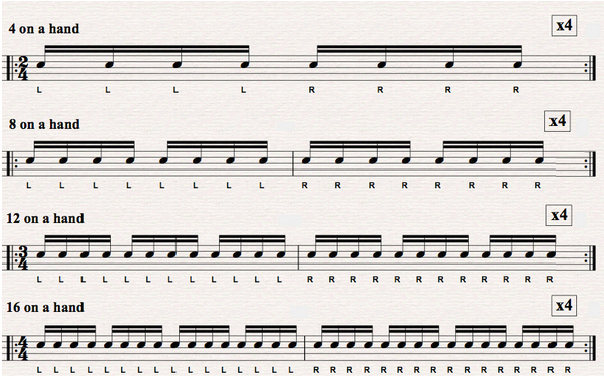The Art of Four Mallets on the Bell Tree
by Cloud Wang

A native Taiwanese, Cloud Wang plays multiple instruments including piano, organ, handbells, carillon, and percussion. In 2010, she received a scholarship at Berklee College of Music in Boston, to major in jazz vibraphone and steel drum performance. The same year, she also received second prize for vibraphone in the Italy Percussion Competition in Fermo, Italy.
In her early music career with five years’ experience as a church music director and organist, Cloud was so fortunate to learn handbell from the best mentor (Mrs. Donna Kinsey in WV) and became a bell hog. She has been an active member of Handbell Musician of America since 2015, receiving scholarships to the National Handbell Seminar and Distinctly Bronze West. She has participated bell festivals in FL, MN, NJ, NY, PA, and TX. Inspired by Barbara Brocker, the bell tree became her favorite.
Cloud stays active as a professional musician and busy to play bell tree at churches in Houston, TX. She has performed numerous concerts in South Korea, Taiwan, United States, and Trinidad and Tobago.
I see the bell tree as a percussion instrument, because I am using mallets to play. I have discovered the power of four mallets, to help me play more musically and look graceful on the stage.
During the summer of 2016, I was granted a scholarship to participate in my first HMA National Seminar in Rochester, NY. At the seminar, I took the bell tree queen Barbara Brocker’s beginnning bell tree class. I was amazed that the bell tree stand could hold three octave bells, all played by one musician. After the seminar finished, I bought a bell tree stand, Barbara’s bell tree keyboard manual, mallets, separator clips, and several pieces of bell tree music, and returned home to start my bell tree journey.
As a beginner, I followed the keyboard manual from page one to learn everything about the bell tree and using two mallets to play. I found it was easy to play a single melody line with two notes harmony.
During the COVID pandemic, I borrowed a church’s set of handbells for practicing at home. One day, I was looking at the complete keyboard layout picture and I decided to try hanging all 37 bells from C4-C7 on the bell tree stand. Whew! It took a while to finish the setting and I wasn’t even sure if I did it right. Afterwards I was speechless and looked at the set up… Wow! This is crazy. How could I play it? I tried to learn the keyboard layout first on two mallets, string by string. Suddenly, I realized that I needed more mallets. So, I switched to four mallets. Because of my music background as a percussionist, I already knew the Burton grip. It became quite natural for me to play the bell tree with four mallets. The difference is all the bells are vertical and it took a long time to find every single note.
In summer 2023, I offered An Introduction to Four Mallets at the “Into the Forest” event to explain the beauty of using four mallets to play the bell tree.
Just like four-in-hand ringing
The four-mallet technique is the same concept as four-in-hand ringing: you can play four notes simultaneously to make a colorful jazzy chord or double octave notes to make a loud sound. You can also play each note independently, which is very handy.
It’s more than the R-L or L-R alternate sticking
In traditional percussion teaching, we are taught that we must always use the alternate stroke (R-L or L-R) to play notes and can’t use the same hand to play repeated notes (ex: R-R, L-L). It sounds logical but it is not always necessary.
Check out any percussion rudiment book and you will see different stroke exercises of right-hand and left-hand combinations, including playing repeated notes by the same hand, such as R-R-R-R, L-L-L-L; or the useful single paradiddle, which is R-L-R-R, L-R-L-L.
Example Bell Tree Rudiment

It’s very challenging to play music on the bell tree keyboard layout. I find that I often use one single hand jumping around playing several notes on the same side between different strings. It feels awkward sometimes. But the beauty of using the four mallets changes the result: two separate mallets on one hand helps carry through notes and makes it smoother and more musical. It also looks more graceful on a visual presentation. So far, I have discovered some unique ways to play big jumping moments between strings. It may look like I am hugging the tree or dancing around the tree but it all works!
Different mallets, different sound
Mallets are the key components to making a different sound. Because of the bell tree range from C4-C8 which is wide, it’s good to have multiple mallets made from different materials, with yarn covering the head or no yarn, for different ranges and dynamics.
It’s all about what kind of sound that you want. The beauty of using the four mallets is that you can use one single type of mallet or up to four different types of mallets at the same time (we call this a “graduated set” in marimba terminology) to make different sounds and dynamics.
There are other useful functions to having four mallets, such as for damping bells or stopping the string of bells from swinging too much during the performance. In an emergency, you can even use a mallet as a substitute bell separator!
There are so many advantages of using four mallets to play, and I’m still discovering more. I encourage you give it a try. It might take a bit of time to develop the skill of holding the mallets without feeling awkward, but it’s worth it when you see and hear the beauty and magic happen.
Here are my suggestions for someone who is interested in trying four mallets:
Find a local percussion teacher and take private lessons to learn the four-mallet technique. Percussion techniques have been developed for centuries and a good teacher can help you save time learning the correct technique and avoid hand injury.
Make some percussion friends to talk about mallets.
And… just do it! It doesn’t matter what kind of grip you are using (traditional, Burton, or Stevens), the most important thing is you must apply what you have learned on the bell tree.
I’m looking forward to seeing more bell tree players playing with four mallets.
I see the bell tree as a percussion instrument, because I am using mallets to play. I have discovered the power of four mallets, to help me play more musically and look graceful on the stage.
During the summer of 2016, I was granted a scholarship to participate in my first HMA National Seminar in Rochester, NY. At the seminar, I took the bell tree queen Barbara Brocker’s beginnning bell tree class. I was amazed that the bell tree stand could hold three octave bells, all played by one musician. After the seminar finished, I bought a bell tree stand, Barbara’s bell tree keyboard manual, mallets, separator clips, and several pieces of bell tree music, and returned home to start my bell tree journey.
As a beginner, I followed the keyboard manual from page one to learn everything about the bell tree and using two mallets to play. I found it was easy to play a single melody line with two notes harmony.
During the COVID pandemic, I borrowed a church’s set of handbells for practicing at home. One day, I was looking at the complete keyboard layout picture and I decided to try hanging all 37 bells from C4-C7 on the bell tree stand. Whew! It took a while to finish the setting and I wasn’t even sure if I did it right. Afterwards I was speechless and looked at the set up… Wow! This is crazy. How could I play it? I tried to learn the keyboard layout first on two mallets, string by string. Suddenly, I realized that I needed more mallets. So, I switched to four mallets. Because of my music background as a percussionist, I already knew the Burton grip. It became quite natural for me to play the bell tree with four mallets. The difference is all the bells are vertical and it took a long time to find every single note.
In summer 2023, I offered An Introduction to Four Mallets at the “Into the Forest” event to explain the beauty of using four mallets to play the bell tree.
Just like four-in-hand ringing
The four-mallet technique is the same concept as four-in-hand ringing: you can play four notes simultaneously to make a colorful jazzy chord or double octave notes to make a loud sound. You can also play each note independently, which is very handy.
It’s more than the R-L or L-R alternate sticking
In traditional percussion teaching, we are taught that we must always use the alternate stroke (R-L or L-R) to play notes and can’t use the same hand to play repeated notes (ex: R-R, L-L). It sounds logical but it is not always necessary.
Check out any percussion rudiment book and you will see different stroke exercises of right-hand and left-hand combinations, including playing repeated notes by the same hand, such as R-R-R-R, L-L-L-L; or the useful single paradiddle, which is R-L-R-R, L-R-L-L.
Example Bell Tree Rudiment

It’s very challenging to play music on the bell tree keyboard layout. I find that I often use one single hand jumping around playing several notes on the same side between different strings. It feels awkward sometimes. But the beauty of using the four mallets changes the result: two separate mallets on one hand helps carry through notes and makes it smoother and more musical. It also looks more graceful on a visual presentation. So far, I have discovered some unique ways to play big jumping moments between strings. It may look like I am hugging the tree or dancing around the tree but it all works!
Different mallets, different sound
Mallets are the key components to making a different sound. Because of the bell tree range from C4-C8 which is wide, it’s good to have multiple mallets made from different materials, with yarn covering the head or no yarn, for different ranges and dynamics.
It’s all about what kind of sound that you want. The beauty of using the four mallets is that you can use one single type of mallet or up to four different types of mallets at the same time (we call this a “graduated set” in marimba terminology) to make different sounds and dynamics.
There are other useful functions to having four mallets, such as for damping bells or stopping the string of bells from swinging too much during the performance. In an emergency, you can even use a mallet as a substitute bell separator!
There are so many advantages of using four mallets to play, and I’m still discovering more. I encourage you give it a try. It might take a bit of time to develop the skill of holding the mallets without feeling awkward, but it’s worth it when you see and hear the beauty and magic happen.
Here are my suggestions for someone who is interested in trying four mallets:
Find a local percussion teacher and take private lessons to learn the four-mallet technique. Percussion techniques have been developed for centuries and a good teacher can help you save time learning the correct technique and avoid hand injury.
Make some percussion friends to talk about mallets.
And… just do it! It doesn’t matter what kind of grip you are using (traditional, Burton, or Stevens), the most important thing is you must apply what you have learned on the bell tree.
I’m looking forward to seeing more bell tree players playing with four mallets.

A native Taiwanese, Cloud Wang plays multiple instruments including piano, organ, handbells, carillon, and percussion. In 2010, she received a scholarship at Berklee College of Music in Boston, to major in jazz vibraphone and steel drum performance. The same year, she also received second prize for vibraphone in the Italy Percussion Competition in Fermo, Italy.
In her early music career with five years’ experience as a church music director and organist, Cloud was so fortunate to learn handbell from the best mentor (Mrs. Donna Kinsey in WV) and became a bell hog. She has been an active member of Handbell Musician of America since 2015, receiving scholarships to the National Handbell Seminar and Distinctly Bronze West. She has participated bell festivals in FL, MN, NJ, NY, PA, and TX. Inspired by Barbara Brocker, the bell tree became her favorite.
Cloud stays active as a professional musician and busy to play bell tree at churches in Houston, TX. She has performed numerous concerts in South Korea, Taiwan, United States, and Trinidad and Tobago.

